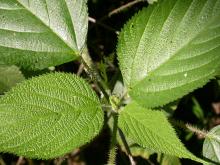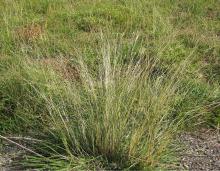Wildflowers, Grasses and Other Nonwoody Plants
Media

Species Types
Scientific Name
Fallopia japonica
Description
One of the worst invasive species in the world, Japanese knotweed can thrive in many places and can even damage foundations of buildings — not to mention the harm it causes in natural habitats. Learn to recognize it so you can prevent its spread.
Media

Species Types
Scientific Name
Ambrosia trifida
Description
Large stands of wind-pollinated giant ragweed commonly form in disturbed areas, causing late-summer misery in the form of hay fever for many Missourians.
Media

Species Types
Scientific Name
Fallopia scandens (formerly Polygonum scandens)
Description
Climbing false buckwheat is a rampant, native, annual or perennial climber that often forms curtainlike masses of twining red stems, covering shrubs and trees. Look for it in moist, open or shaded bottomlands, alluvial valleys, and floodplains.
Media

Species Types
Scientific Name
Laportea canadensis
Description
Wood nettle, or stinging nettle, often forms dense stands in bottomland forests, streamsides, and other places. There, canoeists, anglers, and others try to avoid touching its stinging hairs!
Media

Species Types
Scientific Name
Bothriochloa bladhii
Description
Causasian bluestem and the closely related yellow bluestem are both aggressive, weedy degraders of pasturelands that escape cultivation and endanger native habitats. Learn more about these Old World grasses, and please don’t plant them!
Media

Species Types
Scientific Name
Sorghum halepense
Description
Johnson grass is a native of the Mediterranean that is invasive in our country. It’s a weed that infests cropland and degrades native ecosystems, and heavy infestations are found in all the major river bottoms of Missouri.
Media

Species Types
Scientific Name
All true grasses (species in the grass family)
Description
Missouri has 276 species in the grass family, including well-known crop plants and our native prairie grasses. Distinguishing between the species can be difficult, but it’s easy to learn some basics about the group.
Media

Species Types
Scientific Name
Phalaris arundinacea
Description
Reed canary grass is native to Europe, Asia, and North America, and it varies quite a bit. Our native Missouri version, for instance, is quite different from the Eurasian type that has been widely introduced — and which has proven to be highly invasive.
Media

Species Types
Scientific Name
Bothriochloa ischaemum
Description
Yellow bluestem is a nonnative, aggressive, weedy degrader of pasturelands that escapes cultivation and endangers native habitats. It blooms in Missouri in late June to July, far earlier than our native bluestems.
Media

Species Types
Scientific Name
Platanthera praeclara
Description
Western prairie fringed orchid is endangered and known only from a few northwestern locations in our state. Learn about this showy native wildflower of Missouri’s western prairies, and why it’s so important to preserve our remaining tallgrass prairies.
See Also
About Wildflowers, Grasses and Other Nonwoody Plants in Missouri
A very simple way of thinking about the green world is to divide the vascular plants into two groups: woody and nonwoody (or herbaceous). But this is an artificial division; many plant families include some species that are woody and some that are not. The diversity of nonwoody vascular plants is staggering! Think of all the ferns, grasses, sedges, lilies, peas, sunflowers, nightshades, milkweeds, mustards, mints, and mallows — weeds and wildflowers — and many more!





















